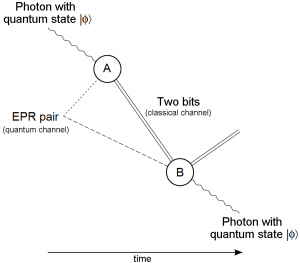Recently, physics blogs have been abuzz with the news that Chinese Researchers had teleported photons almost 100 km in free space. This was followed by another claim on May 17th of teleportation between the Canary Islands at a distance of 143 km . Establishing this distance record was remarkable because entangled photons have a habit of getting interfered with and disentangled. But in just focusing on the distance, the discussion neglected a number that was just as important – how accurate was the information transfer? After all, it’s always possible to increase distance while decreasing fidelity.
The main intended application of quantum teleportation is cryptography, since data cannot be intercepted (though us science fiction writers can come up with something, surely!), so the accuracy of the information is critical. It is not like a casual video feed, where the loss of a few thousand bits here and there doesn’t render the system useless. So what accuracy did the Chinese physicists achieve? Surprisingly, in half a dozen articles on the subject, only one except for the original paper bothered to mention this key statistic. You can read that article here at physicsworld.com. The answer was 80% – four out of five photons were in the correct state. Considering the distance, that’s really not all that bad. The Canary Island test had slightly less fidelity, as you might expect, but it was in the same ballpark.
I don’t think eighty percent is really the quality we’re looking for – whatever the ultimate purpose. Even if this was online video streaming, that would be horrible to watch. For cryptography, that’s entirely insufficient. And you can forget teleporting humans unless you can get down to one error in 1030, though it would require resources that are well beyond our most extreme expectations anyway.
So, from here on, with scientists competing to set distance records, perhaps we need to set some minimum quality conditions. Maybe 90% would be a reasonable start, though ultimately for the transfer of information, we would need a much higher threshold than that. In any case, I really don’t want to see any more articles on science websites that credit a group with breaking a record without bothering to compare the quality of the achievement
All that said, congratulations to the Chinese team and the Canary Islands team for pushing the boundaries. Their actual papers were serious and detailed, and we’re one step closer to quantum cryptography thanks to their efforts.
Thanks for Jon Cartwright over at physicsworld.com for writing up the achievement properly, and also including an illuminating critique of the experiment from Nicholas Gisin of the University of Geneva.
